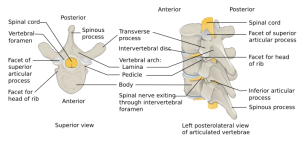Atlanto-occipital dissociation: Difference between revisions
ClaireLewis (talk | contribs) |
|||
| (One intermediate revision by the same user not shown) | |||
| Line 5: | Line 5: | ||
*Also referred to as internal decapitation | *Also referred to as internal decapitation | ||
*[[Down syndrome]] predisposes to atlanto-occipital dislocation | *[[Down syndrome]] predisposes to atlanto-occipital dislocation | ||
{{Vertebral fractures and dislocations types}} | |||
==Clinical Features== | ==Clinical Features== | ||
| Line 11: | Line 13: | ||
==Differential Diagnosis== | ==Differential Diagnosis== | ||
{{ | {{Blunt neck trauma DDX}} | ||
==Evaluation== | ==Evaluation== | ||
Latest revision as of 13:16, 24 October 2020
Background
- Unstable spine fractures
- Tectorial membrane and alar ligaments provide stability to atlanto-occipital joint
- Injury or laxity of these ligaments can lead to subluxation or dislocation
- Also referred to as internal decapitation
- Down syndrome predisposes to atlanto-occipital dislocation
Vertebral fractures and dislocations types
- Cervical fractures and dislocations
- Thoracic and lumbar fractures and dislocations
Clinical Features
- Pure flexion injury involving C1-C2, with or without odontoid fracture
- Often associated with brain injury, which predicts mortality[1]
Differential Diagnosis
Neck Trauma
- Penetrating neck trauma
- Blunt neck trauma
- Cervical injury
- Neurogenic shock
- Spinal cord injury
Evaluation
- Evaluate with the Powers ratio
- Ratio of BC:OA > 1 suggests anterior subluxation
- BC = distance between basion and midpoint of C2 post laminar line
- OA = Distance between opisthion and ant arch of C2
- Basion to dens interval of > 10mm [2]
Management
Prehospital Immobilization
See the NAEMSP National Guidelines for Spinal Immobilization
Hospital
- C-collar
- Consult ortho or spine as needed
Disposition
- Admit
See Also
External Links
References
- ↑ Mendenhall, S. K., Sivaganesan, A., Mistry, A., Sivasubramaniam, P., McGirt, M. J. and Devin, C. J. (2015) ‘Traumatic atlantooccipital dislocation: Comprehensive assessment of mortality, neurologic improvement, and patient-reported outcomes at a level 1 trauma center over 15 years’, The Spine Journal, 15(11), pp. 2385–2395
- ↑ Riascos R, Bonfante E, Cotes C et-al. Imaging of Atlanto-Occipital and Atlantoaxial Traumatic Injuries: What the Radiologist Needs to Know. Radiographics. 2015;35





